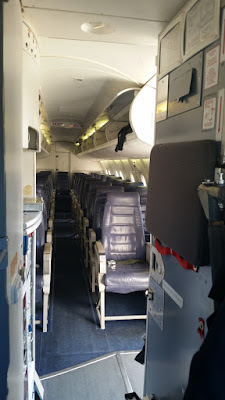"I think I jumped out of one of these when I went skydiving."
"I didn't know this was going to be one of those prop planes. I want off."
 |
| Sunset on a pretty evening at Washington-Dulles. |
In my two years flying what I call "The Little Airliner That Could", I have heard all of the above quotes from passengers about it.
"I miss this thing."
"This is real flying."
"What a great airplane."
I've heard those quotes too... from pilots who used to fly it. I've just finished my last trip as a Dash pilot before I move on to the ERJ-145, so I've now become one of those who used to fly it, and I already say all of those things about it myself.
 |
| Me in the Seattle sim the day before the checkride. |
Sure, it had its issues. It could be loud inside the cabin if its NVS (anti-Noise/Vibration System) wasn't working, which was often. Cancelling out vibration with a system that vibrates isn't exactly a recipe for reliability.
It wasn't easy to get into, since the pedestal between the seats took up all the available space, meaning you had to put one leg in, then swing the other leg up and over to sit down. Once you were in the seat, though, it was quite comfortable.
It was extremely hot in the cockpit when the engines weren't running, since the -200s had no APU (a small engine in the tailcone that provides power and air conditioning) and although the -300s did have APUs, they worked fewer days in a year than Congress.
But it was still the most elegant ugly duckling I'll probably ever have a chance to fly. It looked a bit strange, as there are hardly any high-wing airliners in the U.S. The 200 was stubby-looking, and had the nickname "Baby Dash" because it looked too small. The 400 looked like a gangly teenager that hadn't caught up with a growth spurt yet. But the 300 was almost the perfect size and proportion.
 |
| From this angle, the DHC-8-300 almost looks sleek. |
It doesn't go particularly fast, but it still tops out over 300 MPH. It doesn't go very high, and we very rarely actually went up to its maximum altitude of 25,000 feet, but we didn't need to, because even down low, it burns less fuel doing 300 miles an hour than a lot of planes burn while taxiing.
Since we stayed relatively low, we couldn't get above much of the weather. I liked to joke that we had a hard time topping out valley fog. This meant we ended up slogging through rather than flying over bad weather. Because of this, has a well-earned legendary reputation for being able to carry ice and still fly well—not surprising for a plane that was designed by Canadians.
To address the three comments that started this post and defend my little buddy:
 |
| Stepping on board the Dash for the first of approximately 1000 times. |
It's not a particularly small airplane. The 300 carries just as many passengers as the 145, which is one of the most popular regional airliners in service today. You can't go into any major airport in the country and not see a 145, and yet both it and the Dash carry the same amount of people.
 |
| Looking back from my seat. That's 37 seats there on the stubby one. |
More than once, a passenger has either gotten off the Dash or refused to get on it because "it's a propeller plane". Well, it is and it isn't. It's not a prop like your grandfather's 160-horsepower Cessna with a piston engine. It is powered by two 2200-horsepower jet engines, and those jets just happen to have propellers connected to them. (In fact, before they were called turboprops, this kind of setup was called a "propjet". You can still see that terminology in old aeronautical engineering books.) That means you get the fuel efficiency of a propeller combined with the durability and reliability of a jet engine. It's not the kind of plane you take on a hop around the patch on weekends just because it has props.
Here you can see the jet engine itself inside that long nacelle:
 |
| Yeah, that's really a jet engine under the hood. |
Here's a picture of an early 737. Notice how long and narrow the engine is—just like the Dash's engine, but without a prop:
 |
| Old 737-200 with the cigar shaped engines. Photo by Eduard Marmet. |
 |
| Taxiing the 172 past a -200 in FSX. |
 |
| Killing time on a rainy day. |
Farewell, friend. I'll see you on the other side of that rainbow.
 |
| This rainbow was a good way to end my last Dash trip. |
Next week, I start preparations to move to the jet. See you next Wednesday!
Like Larry the Flying Guy on Facebook:
Follow @Lairspeed
The author is an airline pilot, flight instructor, and adjunct college professor teaching aviation ground schools. He holds an ATP certificate with a DHC-8 type rating, as well as CFI, CFII, MEI, AGI, and IGI certificates, and is a Master-level participant in the FAA's WINGS program and a former FAASafety Team representative. He is on Facebook as Larry the Flying Guy, has a Larry the Flying Guy YouTube channel, and is on Twitter as @Lairspeed.
It takes hours of work to bring each Keyboard & Rudder post to you. If you've found it useful, please consider making an easy one-time or recurring donation via PayPal in any amount you choose.
No comments:
Post a Comment